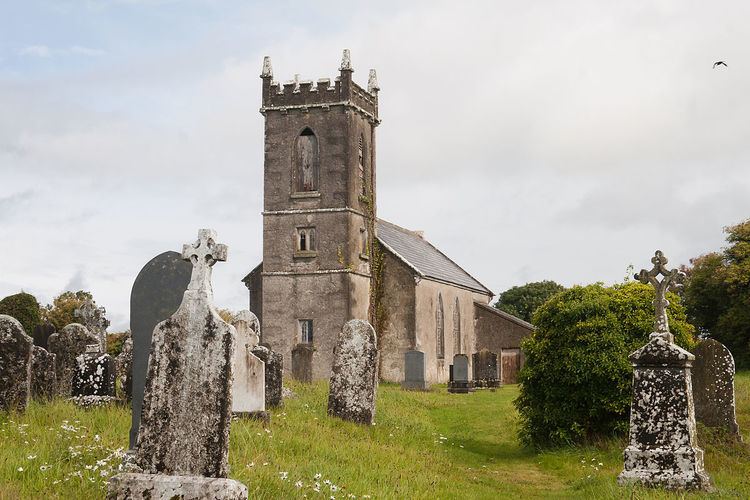The Board of First Fruits (Irish: Bord na Prímhide) was an institution of the Church of Ireland that was established in 1711 by Anne, Queen of Great Britain to build and improve churches and glebe houses in Ireland. This was funded from taxes collected on clerical incomes which were in turn funded by tithes. The board was replaced in 1833 by the Board of Ecclesiastical Commissioners.
From the English Reformation in the 16th century, most Irish people chose to remain Roman Catholic and had by now to pay tithes valued at about 10% of an area's agricultural produce, to maintain and fund the established state church, the Anglican Church of Ireland, to which only a small minority of the population converted. Protests against this situation led to the Tithe war in the early 19th century.
In 1711, Queen Anne agreed that the tax on clerical incomes be given to the Church of Ireland for the building of new churches and Glebe Houses. To that effect, with Jonathan Swift's influence, the Board of First Fruits was founded.
During the first 70 years of its existence, the board purchased glebe lands for benefices at a total cost of £3,543. It also assisted the building of forty-five glebe houses with gifts of £4,080.
In 1778, the Irish Parliament agreed a grant of £6,000, followed by £1,500 in 1779–1780, £6,000 in 1781–1782, £3,000 in 1783–1784 and £5,000 each year from 1785 to 1800. During the period 1791–1803, the board spent £55,600 towards the building of 88 churches and 116 glebe houses.
The grants were maintained after the Act of Union 1800, but the Act of Parliament in 1808 saw a consolidation of the funds and allowed the board to also repair old churches and glebe houses.
From 1808, the annual grant doubled to £10,000 and massively increased to £60,000 each year between 1810 and 1816. Thereafter, the grant was halved between 1817 and 1821, finally being reduced to £10,000 each year in 1822–1823.
In the twenty years following the Act of Union, a total of £807,648 was paid out in grants to purchases glebe lands in 193 benefices, the building of 550 glebe houses, and the building, rebuilding and enlargement of 697 churches.
The Church Temporalities Act 1833 put an end to the Board of First Fruits and The Board of Ecclesiastical Commissioners took over.
Many architects worked for the Board of First Fruits. The following lists a few and is not exhaustive:
George Richard PainJames PainJoseph WellandJohn BowdenJohn SempleWilliam FarrellMany churches and glebe houses were constructed or improved with funding from the Board of First Fruits.
Littleton Church of Ireland, Bally Beg, County Tipperary (Built 1786)Church of Ireland (in ruins), Glebe, County Tipperary (built c1790)*The Old Church, Terryglass, County Tipperary (Built 1808)*Church of Ireland (in ruins), Marshalstown, County Cork (Built c1810)*Killodiernan Church of Ireland, Johnstown, County Tipperary (Built 1811)*Church of Ireland, Borrisokane, County Tipperary (Built 1812) *St. Cronan's Church, Roscrea (Church of Ireland), Roscrea, County Tipperary (Built 1812)*Church of Ireland, Feigh West, County Tipperary (Built 1813)*St. Burchin's Church of Ireland, Ballyhenry, Bourney, County Tipperary (Built 1814)*St. Michael's Church of Ireland (in ruins), Cloonmore, County Tipperary (Built 1815)*St. Ruadan's Church of Ireland, (in ruins) Curraghmore, County Tipperary (Built c1815)*Church of Ireland, Ballynaclogh, County Tipperary (Built 1815)*Madden, County Armagh (Rebuilt 1816)St. Cartach's Church, Castlemaine, County Kerry (Built 1816)*Former Church of Ireland, Templenoe, County Kerry (Built 1816)*Christ Church, Taney Parish, Dundrum, Dublin (Built 1818)Kilcolman Church, Milltown, County Kerry (Built 1819)*Church of Ireland, Kilruane, County Tipperary (Built 1820)*Church of Ireland, Dunkerrin, County Offaly (Built 1820)*St. Philip and St. James Church, Booterstown, Dublin (Built 1821)St. Mary's Church of Ireland, Shinrone, Co. Offaly (Built 1821)*Holycross Church of Ireland, Holycross, County Tipperary (Built 1821)*Kilfithmone Church of Ireland, Kilfithmone, County Tipperary (Built 1821)*St Luke's church, Ballymoyer, County Armagh (Built 1822)Former Church of Ireland, Dromagh, County Cork (Built 1822)*Church of Ireland (in ruins), Kilbiller, County Tipperary (Built 1822)*St.Mary’s Church, Castletownroche, County Cork (Built c1825)*Former St. Mary's Church, Thurles, County Tipperary (Built c1825)*Church of Ireland (in ruins), Modreeny, County Tipperary (Built 1828)*St.Thomas Church of Ireland, Rathmore, County Longford (Built 1829)St. George's Church, Mitchelstown, County Cork (Rebuild of 1830 partially funded by Board)*Monkstown Church, Dublin (Built 1830s)St. Marys Chapel of Ease, Dublin (Built 1830)Taghadoe Church, County Kildare (built 1831)Church of Ireland, Portumna, County Galway (Built 1832)*Church of Ireland, Kilkerrin, County Galway (Built 1784)*Dorrha Church of Ireland, Graigue, Dorrha, County Tipperary (Built 1832)*St. Kieran's Church of Ireland, Cloughjordan, County Tipperary (Built 1837)*Clondrohid, County CorkClondavaddog, County Donegal (Built c1795)Lorrha, County Tipperary (Built 1816)*Feigh West, County Tipperary (Built 1816)*Killeen, County Tipperary (Built 1816)*Dunkitt, County Kilkenny (Built 1817)*Ballymoyer, County Armagh (Built 1825)Loughkeen, County Tipperary (Built c1830)*An asterisk indicates that a building is featured on the website of the National Inventory of Architectural Heritage

